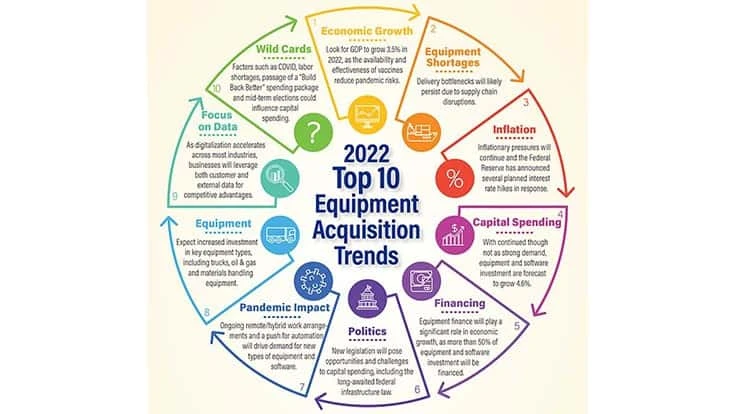
The Washington-based Equipment Leasing and Finance Association (ELFA), which says it represents the nearly $1 trillion equipment finance sector in the United States, has unveiled its Top 10 Equipment Acquisition Trends for 2022. ELFA says “real private investment by U.S. businesses in equipment and software is forecast to be almost $2 trillion in 2022, with a substantial amount of that investment activity financed, so these trends impact a significant portion of the U.S. economy.”
ELFA President and CEO Ralph Petta says, “The pandemic is the underlying theme throughout the trends this year as equipment acquisition continues to drive supply chains across all U.S. manufacturing and service sectors. Nearly 8 in 10 of U.S. businesses use equipment leasing and financing to acquire the productive assets they need to operate and grow.”
ELFA says it distilled recent research and data, including the Equipment Leasing & Finance Foundation’s 2022 Equipment Leasing & Finance U.S. Economic Outlook to forecast the following Top 10 Equipment Acquisition Trends for 2022:
- The U.S. economy will have solid growth in 2022. After a highly volatile 2021, the economy is on more even footing this year, with the widespread availability and effectiveness of vaccines reducing the risks from the pandemic. Potential for economic growth later in the year is substantial, with 3.5 percent gross domestic product growth forecast for 2022.
- Equipment shortages will continue due to supply chain disruptions. Delivery bottlenecks will likely persist, especially if U.S. trading partners shut their borders in response to new virus strains. Businesses will be likely to invest more capital in maintaining inventories of crucial components and develop relationships with new suppliers to reduce the impact of future disruptions.
- High inflation will be a major headwind for the overall economy. In fall 2021, supply chain snags added to inflationary pressures, which will be prolonged this year. The Federal Reserve has announced several planned interest rate hikes in 2022. It remains to be seen what impact, if any, interest rate increases will have on supply or demand.
- Growth in capital spending will continue. Equipment and software investment expanded by more than 15 percent annualized from January to June 2021, which was comparable to the rapid growth of the post-2008/2009 recession. With continued, though not as strong demand, equipment and software investment growth of 4.6 percent is expected.
- Equipment finance will play a significant role in economic growth. Based on historical precedent, more than half of equipment and software investment this year will be financed. In addition, inflationary pressures that drive equipment prices higher will make financing more desirable with payments spread out over time.
- Government fiscal and regulatory policies will pose opportunities and challenges to capital spending. Businesses will need to stay informed on a range of federal and state policy changes that will impact their operations. They include the long-awaited infrastructure spending law enacted by Congress that will have businesses investing in related equipment verticals, and federal and state initiatives that will create more red tape for lenders along with associated costs to borrowers.
- Pandemic-driven changes in the workplace will continue to impact equipment demand. Ongoing remote/hybrid work arrangements will drive demand for new types of equipment and software as businesses continue to adapt to the “new normal.” Automation and AI technologies such as robotics, machine learning and natural language processing will boost the productivity of employees working remotely and fill the void of unavailable labor.
- Many key equipment types will show growth. While equipment and software investment should expand at a healthy rate, growth is likely to be uneven across equipment verticals. Trucks, oil and gas equipment, and materials handling equipment should benefit from sustained demand. Verticals such as automobiles, construction machinery and agricultural equipment may continue to face pandemic-related headwinds such as input shortages, high energy prices and volatile demand conditions.
- Businesses will increase their focus on digitization and data. As investment in digitization accelerates across most industries, businesses will need to leverage both customer and external data for competitive advantages in areas such as customer behavior and market dynamics. Cybersecurity risks will require increasingly robust cyber- and data-security protocols to be implemented.
- “Wild cards” will play a role in business investment decisions. There are other areas in addition to the trends above that businesses will keep an eye on that could impact their equipment acquisition strategies. Continued fallout from the pandemic and future variants, ongoing labor shortages, passage of the “Build Back Better” spending package in Washington, and mid-term elections could all have potential business impacts.
ELFA says its 580 members include independent and captive leasing and finance companies, banks, financial services corporations, brokers/packagers and investment banks, as well as manufacturers and service providers in the equipment sector.
Latest from Waste Today
- City eWaste, Williamson County, Tennessee, offer electronics recycling stations
- Casella commits $1.5M to launch circular economy center at the University of Vermont
- Mavitec Green Energy expands in US market
- Eagle Dumpster Rental identifies its MRF-unfriendly items
- American Securities acquires Integrated Global Services Inc.
- Fleetio integrates Maintenance Shop Network add-in
- 3rd Eye expands suite of fleet safety solutions
- Biffa sees recycling, composting opportunities at events





